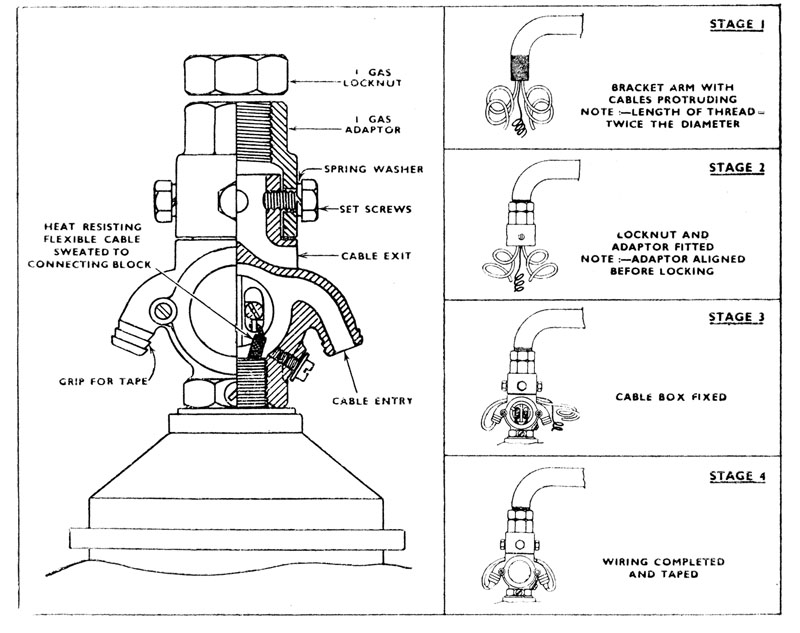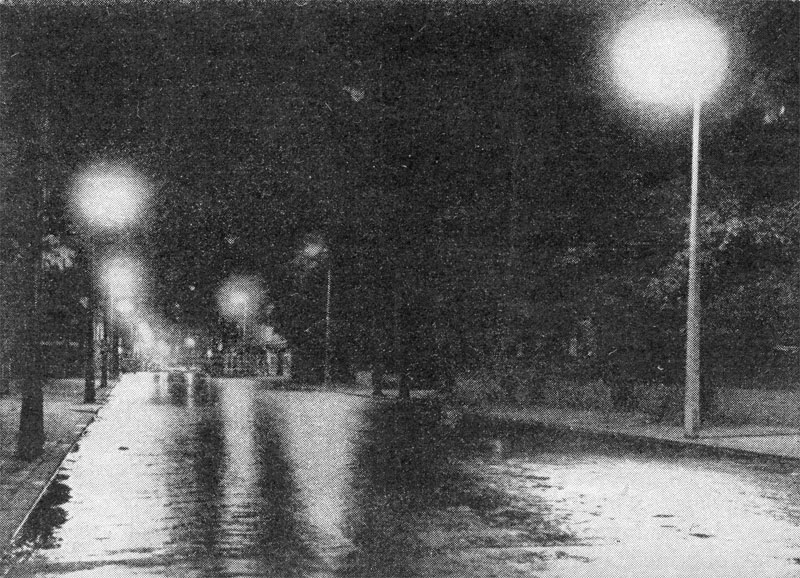|
GEC

|
GEC
The General Electric Co. Ltd
Magnet House
Kingsway
London WC2
England
|

1914 logo
|

Mid 1930s logo
|
In 1908, the firm is the first company in England to manufacture drawn tungsten filament electric lamps, after many years experience of
making carbon filament lamps. - [Golden Jubilee, Public Lighting, 1974]
Paterson joins the firm in 1918 to establish and direct the research laboratories. Up to the beginning of the
war, the GEC research organisation had grown to over 500 people; it was amongst the
largest in the country, with a world-wide reputation for scientific and technical services. It is the first
industrial research laboratory in the British Empire to engage in fundamental research - Public Lighting #23, 1941, [Golden Jubilee, Public Lighting, 1974]
In 1927, develop and introduce the first Rough Service lamps using vibration and shock resistant thoria
tungsten wire - known universally for several decades as Magnet Wire. - [Golden Jubilee, Public Lighting, 1974]
The principles of street lighting by accentuated contrast were discovered by the Research Labaoratories
and applied with tungsten street lighting in 1930. - [Golden Jubilee, Public Lighting, 1974]
Market the first practical medium pressure mercury lamp in the world in 1932. - [Golden Jubilee, Public Lighting, 1974]
Install the world's first commercial installation of medium-pressure mercury vapour lamps and lanterns along
Watford Road, Wembley, in 1933. - [Golden Jubilee, Public Lighting, 1974]
In 1934 develop the first practical commercial high voltage coiled-coil tungsten filament lamp in England. - [Golden Jubilee, Public Lighting, 1974]
Exhibits included street lighting lanterns specially designed for Osram Tungsten filament gas-filled
and Osram high-pressure Mercury Vapour lamps (MA) including an entirely new type of dual
purpose lantern for accommodating either types of lamps. Another new lantern exhibited was
one designed especially for use with the 150W MA/H. The well known Lewisham and
Di-Fractor types were also on display. - Public Lighting #3, 1936
The firm are exhibiting the "well-known" Di-fractor lantern with 400W MA/V lamps at the
Folkestone APLE conference in 1937 to the recommendations of the interim report of the
Ministry of Transport Departmental Committee on Street Lighting.
A cut-off system of lighting using a new type of GEC lantern is also exhibited, which burns the lamp horizontally
without any additional gear, and leads to a very compact lantern with internal silvered mirrors.
The Plafractor lantern is also being exhibited. - APLE Conference Programme 1937

The vast possibilities of a system for centralised control of street lighting
and air raid signals, developed by the GEC, were demonstrated by a
model at the I.M.E.A. Convention at Torquay. The system employs carrier currents
of musicial frequencies superimposed upon the supply network conductors. Pilot wires
are not required. A variable speed motor-alternator set at the substation provides
the range of frequencies from which one can be selected to operate various tuned
relays installed at the controlled points. (These frequencies range from 200 to
800 cycles per second and are chosen to avoid the harmonics and resonant frequencies
of the power network.) Usually six to eight frequencies can be catered for without
difficulty. In light of ARP schemes, and in addition to the advantage of controlling
street lights, buzzers can be installed in all houses of air raid wardens and operated
from the control point. It would be possible to apply the system to the control of
water heaters throughout the supply area if any project should be entertained involving
the provision of cheaper current subject to the power for this service being cut
off during peak periods. The demonstration model consists of a primary substation feeding
a secondary substation, both situated on roads illuminated by street standards.
At the primary substation is fitted a small control panel, at which street lights can
be switched on or off, either completely or in groups. The model also includes a buzzer
as a warning signal in the house of an air raid warden. - Public Lighting #10, 1938
Two new lanterns take centre stage: the new Difractor (for burning mercury lamps vertically) and the
new Horizal (for burning them horizontally). The Horizal uses a magnetic deflector to control
the arc. Wax filled chokes are also being exhibited along with the GEC's centralised control of
street lighting which works on the ripple system. - APLE Conference Programme 1938
A second model was produced in late 1937 or early 1938 to illustrate the recommendations of
the MOT Final Report. It featured a realistic system of streets bounded by houses, cinemas
and factories. The model measured 5' long by 2' wide, the lighting columns, road and spacing being to a scale
of 1':380'. Running the whole length of the model was a main arterial road - this was lighted by columns providing a mounting
height of 25'. The two sections of the arterial road, which was divided by a roundabout, was over 40' wide:
this was lit by a staggered arrangement of units not more than 150' apart, with an auxiliary unit centrally
suspended every third position, so that there was no dark central section of the road. After the roundabout
the road was made into a dual carriageway, the central reservation being over 6' broad. Dual carriageways
were treated as two separate roads, each having a staggered arrangement of lighting points with an average
spacing of 150'. The fact that the central island was more than 6' broad necessitated the use of a column
carrying two lanterns, each lantern being suspended over its own carriageway. Where the dual road bent
away the lighting points became closer and positioned on the outside of the bend only. Branching from the roundabout
was another road which shortly divided into two, the major portion becoming an S bend. Round this bend the
spacing became very close in accordance with the rule that says the angular separation between lighting points
should not exceed a certain number of degrees. Other examples included lanterns that indicated to side road
traffic that a main road is ahead; cross-road lighting with lights arranged just beyond the crossing;
and roundabout lighting. The model was installed at Magnet House, London, and could be viewed there.
- Public Lighting #11, 1938
The Horizal and the newly introduced Uniway lanterns are being
exhibited, and heavily promoted, by the firm for this conference. The Horizal was the first lantern to be
designed for side entry whilst the Uniway was an entirely new concept for the
lighting of dual carriageways. - APLE Conference Programme 1939

Drip proof terminal box used in earlier top-entry lanterns - 1939 Paper
Major emphasis is given to the GEC Ripple Control with a separate
advert and demonstration. It works by superimposing an audio frequency signal
(or ripple) over the 50Hz power supply at a central point (usually a substation).
The ripple signal is picked up at the receiving end (a street light) by a specially
tuned relay which only responds to select frequency. They are also display
a wide range of modern street lighting lanterns (including the
Side Entry Di-Fractor, Double Dish and
Totally Enclosed Cut-Off lanterns) but note that the
"casual design treatment of earlier years is no longer adequate for modern
requirements. The solution is to offer a range of lanterns, each with a
specific application rather than a multiplicity of types differing
only in their external appearance." - APLE Conference Programme 1945
A wide range of G.E.C. lanterns are being shown. Three new designs are
being exhibited along with three lanterns previously exhibited. The three new lanterns
are the Facetted Reflector Lantern, Side Street Lantern (for OSIRA Sodium Lamps)
and the Main Road Lantern for Large Sodium Lamps. Previously exhibited lanterns
are the Difractor, Uniway and (newly named) Dioptrion. It is the first
time the G.E.C. have exhibited sodium lamps. - APLE Conference Programme 1946
They claim the first UK installation of 5 ft. fluorescent tube lanterns along Brompton Road, Kensington in
1946. This is disputed as there are at least two previous installations by BTH (in Rugby and Old Bond Street, London).
All were trials but the GEC later overlooked this fact. - [Golden Jubilee, Public Lighting, 1974]

Installation of GEC Four-Eighty lanterns along Hoghton Street in Southport for the APLE 1947 conference.
Installed a special demonstration of modern fluorescent lanterns (the Four-Eighty) in Southport for
the APLE's conference. - APLE Conference Programme 1947
In 1952, introduce triple coil cathodes for fluorescent tubes, giving improved life and performance. - [Golden Jubilee, Public Lighting, 1974]
Install the first cold cathode street lighting installation in the world along Union Street in Aberdeen in 1954. - [Golden Jubilee, Public Lighting, 1974]
Introduce the first integral (SOI) low pressure sodium lamp with an efficacy of 85 l/w in 1955. - [Golden Jubilee, Public Lighting, 1974]
In 1956, install the world's first integral sodium lamp installation in the Metropolitan Borough of St. Pancras, London. - [Golden Jubilee, Public Lighting, 1974]
Introduce gold film as a heat reflecting layer to low pressure sodium lamps, increasing the efficacy to
100 l/w in 1960. - [Golden Jubilee, Public Lighting, 1974]
Install the first motorway lighting installation in the U.K. on the elevated section of the M4 between
Chiswick and Langley, Bucks., in 1964. 200W linear sodium lamp lanterns are used. - [Golden Jubilee, Public Lighting, 1974]
In 1965, install the first High Mast lighting in the UK, in The Cumberland Basin, Bristol, using 25 metre
masts and 1000W MBF/U lamps. - [Golden Jubilee, Public Lighting, 1974]
Also in 1965, install the first trial installation of mercury iodide lamps in the UK in
Shaw, Manchester. - [Golden Jubilee, Public Lighting, 1974]
In 1966, arranged the first installation of high pressure sodium lamps in the UK along East Lane,
Wembley. These are marketed as the Solarcolour Lamp. - [Golden Jubilee, Public Lighting, 1974]
Also in 1966, installed the first UK installation of High Mast lighting using low pressure sodium lamp
lanterns at the Brent Cross Flyover, Hendon, London. 30 metre masts and 180W SOX lamps. - [Golden Jubilee, Public Lighting, 1974]
In 1967, installed the first commercial lighting installation in the UK using high pressure sodium lamps (SON)
at Southend-On-Sea in Essex. - [Golden Jubilee, Public Lighting, 1974]
In 1968, invented and marketed the first plug-in high-pressure sodium Solarcolour Lamps
(310W and 360W) to replace 400W mercury lamps without change of control gear. - [Golden Jubilee, Public Lighting, 1974]
In 1968, installed the first motorway lighting in Scotland in the M8 at Renfrew. Cut-off lanterns with
135W SOX lamps were used. - [Golden Jubilee, Public Lighting, 1974]
Also in 1968, installed the first UK installation of High Mast lighting using high pressure sodium
lamp lanterns, at Huddersfield, 25 metre masts and 400W HPS lamps. - [Golden Jubilee, Public Lighting, 1974]
References:
The Illuminating Engineer 1928
APLE Exhibition Catalogue Blackpool 1932
APLE Conference Programme Folkestone 1937
APLE Conference Programme Bournemouth 1938
APLE Conference Programme Glasgow 1939
APLE Conference Programme Glasgow 1945
APLE Conference Programme London 1946
APLE Conference Programme Southport 1947
- External Links:
- Grace's Guide
|



